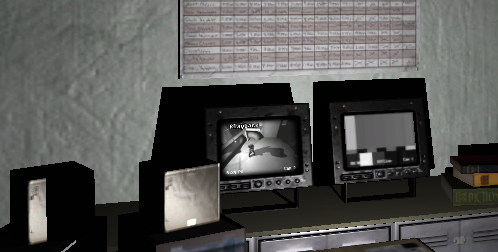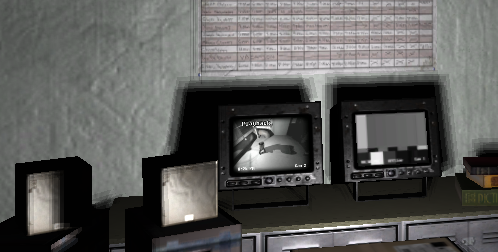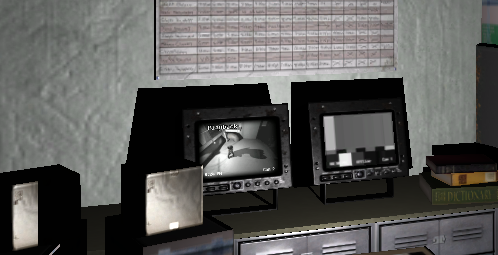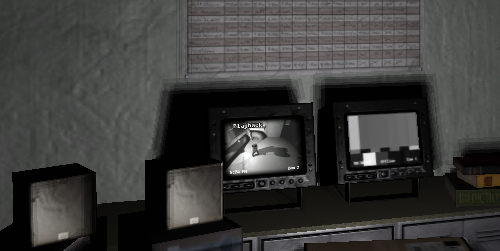F.E.A.R. GPU Performance Tests: Setting a New Standard
by Josh Venning on October 20, 2005 9:00 AM EST- Posted in
- GPUs
The Failure of Soft Shadows and Parallax Mapping
Soft Shadows
We've seen how soft shadows can be used effectively in games like The Chronicles of Riddick, and Monolith has decided to add this as an option in FEAR. Used correctly, soft shadows greatly enhance lighting in a game by giving shadows cast by objects different levels of darkness making them more realistic. This process can take up a lot of processing power however, and that's no exception for FEAR.
Basically, soft shadows are an effect that show how shadows tend to fade at the edges or cast overlapping lines on walls or objects depending on different factors such as light angle and distance. If you've ever made a shadow-puppet, you can see this clearly, as multiple outlines of your hand shadow overlap on the wall with varying degrees of darkness (depending on the light source). And if you were to move your hand closer or farther away from the light, you can see how the soft shadows change dynamically.
The idea is to capture this effect in a game environment, but as any programmer would know, translating this to a game engine can be a very complex undertaking. Not only that, but as we mentioned before, calculating multiple shadows in real time can quickly become a major leech of processing power. With FEAR, we've seen how big of a performance hit that we had when we enabled soft shadows, but you may wonder, "does the effect at least look good?"
The short answer is "no". The way that FEAR incorporates soft shadows ends up looking unrealistic; more stratified and strange than soft. It simply looks as though the game draws multiple shadows at the edges of objects and offsets them up, down, left and right very slightly at different degrees of darkness regardless of the light source. This wouldn't be so bad if the multiple shadows were not readily noticeable as such. It also would have been nice if the "blur factor" were more dynamic; in other words, moving the shadows closer together or farther apart given where the object (say an enemy soldier) is in relation to the light sources and shadowed surfaces.
This is difficult to understand until you see it happening in the game, but you can get a better idea of it by looking at a few pictures. We took some screen shots of a scene with and without soft shadows enabled with both NVIDIA and ATI cards. Please ignore the slight lighting and position differences of these screens.
Parallax Mapping
While the detailed textures, excellent lighting, well done static and dynamic shadows (in spite of the soft shadow issue), large intricate particle systems, and various beautiful effects of FEAR come together to form an immersive and fluid graphical experience, there are a few caveats. To their credit, Monolith was very aggressive with the features that they included and are on the leading edge of technology. The use of a deep parallax mapping algorithm to represent damage is a very cool idea, but the implementation used in FEAR doesn't include key features such as self-occlusion and self-shadowing. When passing a wall with a chunk blown out, the hole will swim around, flatten out, and eventually look like unidentifiable goo stuck to the wall as the angle gets very steep.
The parallax mapping used looks great from angles where the entire interior of a hole can be seen. The problem occurs at viewing angles where a near edge would need to block the view of part of (or the entire) interior of the indention. Rather than occluding anything, parts of the texture that should become invisible are still shown (albeit distorted). This completely destroys the illusion of depth at steep angles by making the texture kind of swim until it totally loses its three-dimensionality. There are algorithms available that can represent correctly self-occlusion in parallax mapping. While we can appreciate cheaper parallax mapping algorithms as a kind of upgraded bump mapping, dramatic surface deformation should either be done more correctly or not at all in cases where the viewer can move to angles that break the effect.
But again, we would love to give credit where credit is due. We would rather see game developers experiment with new technology and put something out there than let the true power of our graphics cards remain dormant. Monolith was ahead of the curve with the graphics in Tron 2.0, and they haven't let us down with the quality of FEAR.
Soft Shadows
We've seen how soft shadows can be used effectively in games like The Chronicles of Riddick, and Monolith has decided to add this as an option in FEAR. Used correctly, soft shadows greatly enhance lighting in a game by giving shadows cast by objects different levels of darkness making them more realistic. This process can take up a lot of processing power however, and that's no exception for FEAR.
Basically, soft shadows are an effect that show how shadows tend to fade at the edges or cast overlapping lines on walls or objects depending on different factors such as light angle and distance. If you've ever made a shadow-puppet, you can see this clearly, as multiple outlines of your hand shadow overlap on the wall with varying degrees of darkness (depending on the light source). And if you were to move your hand closer or farther away from the light, you can see how the soft shadows change dynamically.
The idea is to capture this effect in a game environment, but as any programmer would know, translating this to a game engine can be a very complex undertaking. Not only that, but as we mentioned before, calculating multiple shadows in real time can quickly become a major leech of processing power. With FEAR, we've seen how big of a performance hit that we had when we enabled soft shadows, but you may wonder, "does the effect at least look good?"
The short answer is "no". The way that FEAR incorporates soft shadows ends up looking unrealistic; more stratified and strange than soft. It simply looks as though the game draws multiple shadows at the edges of objects and offsets them up, down, left and right very slightly at different degrees of darkness regardless of the light source. This wouldn't be so bad if the multiple shadows were not readily noticeable as such. It also would have been nice if the "blur factor" were more dynamic; in other words, moving the shadows closer together or farther apart given where the object (say an enemy soldier) is in relation to the light sources and shadowed surfaces.
This is difficult to understand until you see it happening in the game, but you can get a better idea of it by looking at a few pictures. We took some screen shots of a scene with and without soft shadows enabled with both NVIDIA and ATI cards. Please ignore the slight lighting and position differences of these screens.




Parallax Mapping
While the detailed textures, excellent lighting, well done static and dynamic shadows (in spite of the soft shadow issue), large intricate particle systems, and various beautiful effects of FEAR come together to form an immersive and fluid graphical experience, there are a few caveats. To their credit, Monolith was very aggressive with the features that they included and are on the leading edge of technology. The use of a deep parallax mapping algorithm to represent damage is a very cool idea, but the implementation used in FEAR doesn't include key features such as self-occlusion and self-shadowing. When passing a wall with a chunk blown out, the hole will swim around, flatten out, and eventually look like unidentifiable goo stuck to the wall as the angle gets very steep.
The parallax mapping used looks great from angles where the entire interior of a hole can be seen. The problem occurs at viewing angles where a near edge would need to block the view of part of (or the entire) interior of the indention. Rather than occluding anything, parts of the texture that should become invisible are still shown (albeit distorted). This completely destroys the illusion of depth at steep angles by making the texture kind of swim until it totally loses its three-dimensionality. There are algorithms available that can represent correctly self-occlusion in parallax mapping. While we can appreciate cheaper parallax mapping algorithms as a kind of upgraded bump mapping, dramatic surface deformation should either be done more correctly or not at all in cases where the viewer can move to angles that break the effect.
But again, we would love to give credit where credit is due. We would rather see game developers experiment with new technology and put something out there than let the true power of our graphics cards remain dormant. Monolith was ahead of the curve with the graphics in Tron 2.0, and they haven't let us down with the quality of FEAR.










117 Comments
View All Comments
Le Québécois - Thursday, October 20, 2005 - link
Like many peoples said it would have been nice to see older generation HW...especially on ATI side of thing since most of the card tested here are nowhere to be found on the market.Seeing performance with the X800XL and the X850XT would have been nice.
I also hope you'll do some CPU testing in the future since I doubt you'll see many peoples out there with AMD FX55...especially paired up with the like of X1300... :)
Kogan - Thursday, October 20, 2005 - link
Since the max upgrade for AGP users on the ATI side is an X800xt/x850xt, it would have been nice to have seen one of them included.ballero - Thursday, October 20, 2005 - link
I'm looking forward to the SLI numbersAbecedaria - Thursday, October 20, 2005 - link
It is a significant error that SLI numbers were left out of the article since it seems to be about how fast current video card technologies can play the game:"Those who want to play FEAR at the highest resolution and settings with AA enabled (without soft shadows) will basically have to use the 7800 GTX, as no other card available gets playable framerates at those settings, and the 7800 GTX does just barely (if uncomfortably)." ...unless you have an SLI setup, I assume. Does Anandtech feel that SLI is not a viable graphics technology or am I missing something?
And then there's Crossfire... while it STILL isn't available yet, it would have been interesting to see some performance numbers along with SLI tests.
I'd would be nice if you could update the article with dual card frame-rates.
abc
Abecedaria - Thursday, October 20, 2005 - link
Oh wait!!!!PC Perspective has already beat Anandtech to the punch on this subject, and the results show that SLI has a SIGNIFICANT impact on playability, even without any driver optimizations....
http://www.pcper.com/article.php?aid=175&type=...">http://www.pcper.com/article.php?aid=175&type=...
abc
Ender17 - Thursday, October 20, 2005 - link
I agree. Can we get some SLI benchmarks?Kyanzes - Thursday, October 20, 2005 - link
...to see a card performing on the top when it's not even available...9nails - Saturday, October 22, 2005 - link
Exactly! I love this Land of Make Believe. It's a good thing that I have a AMD Athlon 64 FX-55 2.6 GHz processor in my Desktop, Laptop, and PDA. And I'm loving it because after an unreal CPU like that, I would still have hundreds of dollars left to burn on make-believe GPU's. Because, if I was only a regular Joe Anad-reader with a middle tier Pentium 4 and old school AGP graphics port I would be quite upset that the author is targeting his reviews at the well connected Beverley Hills posh.Just who is Josh writing his articles for any way?! I'm going back to surfing pr0n. Because I have a far better chance at dating a porn* than owning a system like the one that he's showing scores on.
yacoub - Saturday, October 22, 2005 - link
Well thanks for supporting the thread I started in Video forum section last week addressing that very issue. All the idiots came out of the woodwork to do their best to misinterpret and misread the post and very few actually bothered to support my suggestion that a test be done with a REAL WORLD system most of us own, not an FX-55 setup with a 7800GTX that few people own.I'd LOVE to see how modern games perform on a system I'm actually thinking of buying, not an imaginary supersystem.
deathwalker - Thursday, October 20, 2005 - link
You know..it's simply come to the point to where I don't know how the average gamer can keep up. It's come to the point to where if you are not willing to spend $300-$500 every 6-12 mos. or so you just can not keep up with the demands that games are putting on computer hardware. This is stupid..I mean who the hell is dragging this industry along? Do they develop new and more powerful hardware so more demanding software can be created or do they develop more demanding software making it a necessity to develop more powerful hardware? Is all this crap really needed to have a decent gaming experience? I guess I'm just gonna have to starve the Cat for the couple of months so I can toss out my POS 6800gt and get some new wizzbang graphics cards the industry wants me to buy. This has become a never ending process that is wearing thin on me.